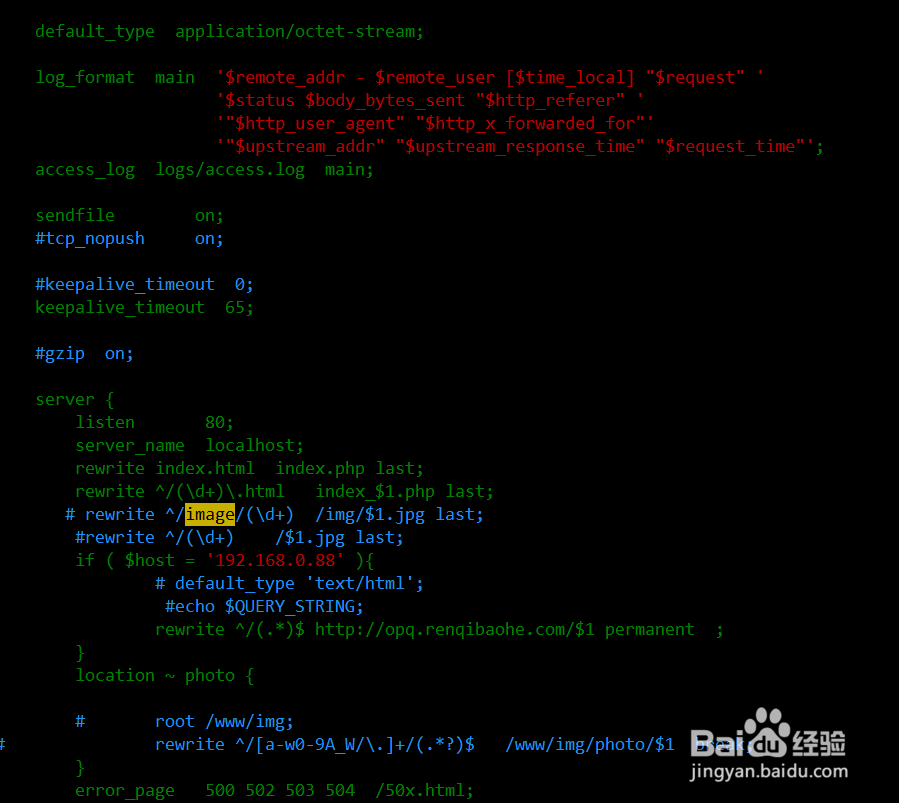nginx 匹配(重定向)
1、精准匹配
location / {
root /www;
index aa.html index.html index.htm;
}
location = /{
root html;
index index.php;
}
先执行index.php
http://192.168.0.89/aa.html 这个会访问 www下的aa.html
2、正则匹配查找匹配/www/image
location ~ image {
root /www;
index index.html;
}
在/www/image下查找图片
精准匹配->普通匹配->正则
3、安装echo模块
1. 首先下载模块源码:https://github.com/agentzh/echo-nginx-module/tags2. 解压到某个路径,假设为 /path/to/echo-nginx-module3. 使用下面命令编译并安装 Nginx wget 'http://sysoev.ru/nginx/nginx-1.0.11.tar.gz'$ tar -xzvf nginx-1.0.11.tar.gz
cd nginx-1.0.11/# Here we assume you would install you nginx under /opt/nginx/.
./configure --prefix=/opt/nginx \--add-module=/path/to/echo-nginx-module
make -j2
make install
切记先停止nginx然后 重新加载配置文件启动nginx
/usr/local/nginx/sbin/nginx -c /usr/local/nginx/conf/nginx.conf
4、nginx 语法:
“=”判断相等
“~”正则匹配(此处区分大小写)
~* 不区分大小写匹配
!~:与指定正则表达式模式不匹配时返回“真”,判断匹配与否时区分字符大小写;
!~*:与指定正则表达式模式不匹配时返回“真”,判断匹配与否时不区分字符大小写;
文件/文件夹判断
if ( $http_user_agent ~ Trident ){
rewrite ^.* index.html;
break;
# return 404;
}
-f, !-f:判断指定的路径是否为存在且为文件;
-d, !-d:判断指定的路径是否为存在且为目录;
-e, !-e:判断指定的路径是否存在,文件或目录均可;
-x, !-x:判断指定路径的文件是否存在且可执行;
location /hello {
default_type 'text/html';
set $u $document_root$fastcgi_script_name;
if ( !-d $u ) {
return 404;
}
}
引用别人的
http://blog.csdn.net/iinel/article/details/4321383
利用
more fastcgi.conf
可以查看nginx的变量
5、调到指定域名
if ( $host = '192.168.0.89' ){
# default_type 'text/html';
#echo $QUERY_STRING;
rewrite ^/(.*)$ http:shangqianqian.com/$1 permanent ;
}
解释一下这几个东西:
last : 相当于Apache的[L]标记,表示完成rewrite
break : 停止执行当前虚拟主机的后续rewrite指令集
redirect : 返回302临时重定向,地址栏会显示跳转后的地址
permanent : 返回301永久重定向,地址栏会显示跳转后的地址
因为301和302不能简单的只返回状态码,还必须有重定向的URL,这就是return指令无法返回301,302的原因了。
这里 last 和 break 区别有点难以理解:
last一般写在server和if中,而break一般使用在location中
last不终止重写后的url匹配,即新的url会再从server走一遍匹配流程,而break终止重写后的匹配
break和last都能组织继续执行后面的rewrite指令
rewrite index.html index.php last; index.html跳转到index.php文件
rewrite ^/(\d+)\.html index_$1.php last; 输入2.html实际访问的是index_2.php
rewrite ^/image/(\d+) /img/$1.jpg last; 输入http://192.168.0.89/image/2实际访问的是根下的img/2.jpg
rewrite ^/(\d+) /$1.jpg last; 输入这个http://192.168.0.89/2实际访问的是根路径下的2.jpg
6、1.html 文件添加如下代码
<img src='./photo/1.jpg'/>
nginx.conf添加如下代码
location ~ photo {
root /www/img;
}
这个图片实际访问的就是 /www/img/photo/1.jpg
location ~ photo {
# root /www/img; 重定向到别的文件下
# rewrite ^/[a-w0-9A_W/\.]+/(.*?)$ /www/img/photo/$1 break; 测试好像只能在根目录下
}
可以瞅瞅这个:
https://segmentfault.com/a/1190000002797606#articleHeader6

7、文件供参考(有点乱)
log_format main '$remote_addr - $remote_user [$time_local] "$request" '
'$status $body_bytes_sent "$http_referer" '
'"$http_user_agent" "$http_x_forwarded_for"'
'"$upstream_addr" "$upstream_response_time" "$request_time"';
access_log logs/access.log main;
sendfile on;
#tcp_nopush on;
#keepalive_timeout 0;
keepalive_timeout 65;
#gzip on;
server {
listen 80;
server_name localhost;
if ( $host = '192.168.0.88' ){
# default_type 'text/html';
#echo $QUERY_STRING;
rewrite ^/(.*)$ http://opq.renqibaohe.com/$1 permanent ;
}
#limit_conn test 1;
#charset koi8-r;
#access_log logs/host.access.log main;
rewrite /image/tmig.jpg /img/tmig.jpg break;
location /hello {
# default_type 'text/html';
# echo $QUERY_STRING;
# set $u $document_root$fastcgi_script_name;
# echo $u;
root /www;
index index.html;
rewrite ^/image/(.*)$ /img/$1 last;
# if ( !-d $u ) {
# return 404;
# }
}
location =/index.html {
root /www;
default_type 'text/html';
echo $document_root$fastcgi_script_name;
index aa.html index.html index.htm;
}
#location = / {
# proxy_pass http://www.baidu.com;
#}
location /{
root html ;
default_type 'text/html'; #如果没有这个default_type,则会一直下载文件而不是输出在浏览器上
#echo $echo_client_request_headers;
#echo_read_request_body;
#echo $request_body;
echo $http_user_agent;
if ( $http_user_agent ~ Trident ){
rewrite ^.* index.html;
break;
# return 404;
}
if ( $remote_addr = '192.168.0.107'){
echo "delay";
}
if ( -e $document_root$fastcgi_script_name ) {
#echo $document_root$fastcgi_script_name;
#rewrite ^.* index.html;
return 404;
# break;
}
echo $request_method;
echo 'fjslfdjdslfjs';
index index.php;
}
location /index.html{
root html;
index index.html;
}
#location ~ image {
# rewrite ^/image/(.*) /img/$1 last;
# root /www;
#}
location /foo {
default_type 'text/html'; #如果没有这个default_type,则会一直下载文件而不是输出在浏览器上
echo 'fsfsd';
#if($host != '192.168.0.107'){
#default_type 'text/javascript'; #如果没有这个default_type,则会一直下载文件而不是输出在浏览器上
# echo $echo_client_request_headers;
# echo_read_request_body;
# echo $request_body;
#}
}
#error_page 404 /404.html;
# redirect server error pages to the static page /50x.html
#
error_page 500 502 503 504 /50x.html;
#location = /50x.html {
# root html;
#}
# location =/1.html{
#
# root /usr/local/nginx/html;
# limit_req zone=allips burst=5 nodelay;
# }
# proxy the PHP scripts to Apache listening on 127.0.0.1:80
#
#location ~ \.php$ {
# proxy_pass http://127.0.0.1;
#}
# pass the PHP scripts to FastCGI server listening on 127.0.0.1:9000
#
location ~ \.php$ {
root /usr/local/nginx/html;
fastcgi_pass 127.0.0.1:9000;
fastcgi_index index.php;
fastcgi_param SCRIPT_FILENAME /usr/local/nginx/html/$fastcgi_script_name;
include fastcgi_params;
}
# deny access to .htaccess files, if Apache's document root
# concurs with nginx's one
#
#location ~ /\.ht {
# deny all;
#}
}
# another virtual host using mix of IP-, name-, and port-based configuration
#
echo "delay";
}
if ( -e $document_root$fastcgi_script_name ) {
#echo $document_root$fastcgi_script_name;
#rewrite ^.* index.html;
return 404;
# break;
}
echo $request_method;
echo 'fjslfdjdslfjs';
index index.php;
}
location /index.html{
root html;
index index.html;
}
#location ~ image {
# rewrite ^/image/(.*) /img/$1 last;
# root /www;
#}
location /foo {
default_type 'text/html'; #如果没有这个default_type,则会一直下载文件而不是输出在浏览器上
echo 'fsfsd';
#if($host != '192.168.0.107'){
#default_type 'text/javascript'; #如果没有这个default_type,则会一直下载文件而不是输出在浏览器上
# echo $echo_client_request_headers;
# echo_read_request_body;
# echo $request_body;
#}
}